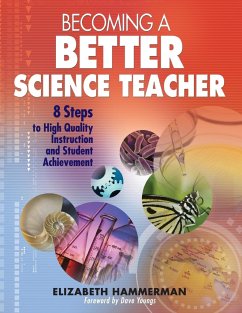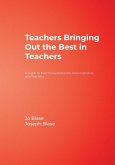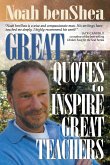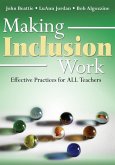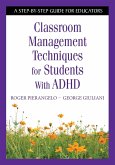Elizabeth Hammerman
Becoming a Better Science Teacher
8 Steps to High Quality Instruction and Student Achievement
Elizabeth Hammerman
Becoming a Better Science Teacher
8 Steps to High Quality Instruction and Student Achievement
- Broschiertes Buch
- Merkliste
- Auf die Merkliste
- Bewerten Bewerten
- Teilen
- Produkt teilen
- Produkterinnerung
- Produkterinnerung
The author provides teacher-friendly tools, insights, sample lessons, and strategies for delivering quality, standards-based science curriculum and instruction that ensures student achievement.
Andere Kunden interessierten sich auch für
![Teachers Bringing Out the Best in Teachers Teachers Bringing Out the Best in Teachers]() Jo BlaseTeachers Bringing Out the Best in Teachers31,99 €
Jo BlaseTeachers Bringing Out the Best in Teachers31,99 €![Brain-Compatible Mathematics Brain-Compatible Mathematics]() Diane RonisBrain-Compatible Mathematics36,99 €
Diane RonisBrain-Compatible Mathematics36,99 €![Great Quotes to Inspire Great Teachers Great Quotes to Inspire Great Teachers]() Noah BensheaGreat Quotes to Inspire Great Teachers32,99 €
Noah BensheaGreat Quotes to Inspire Great Teachers32,99 €![Teaching English Language Learners K-12 Teaching English Language Learners K-12]() Jerry JesnessTeaching English Language Learners K-1231,99 €
Jerry JesnessTeaching English Language Learners K-1231,99 €![Making Inclusion Work Making Inclusion Work]() John BeattieMaking Inclusion Work39,99 €
John BeattieMaking Inclusion Work39,99 €![What Teachers Should Know But Textbooks Don't Show What Teachers Should Know But Textbooks Don't Show]() Stella ErbesWhat Teachers Should Know But Textbooks Don't Show29,99 €
Stella ErbesWhat Teachers Should Know But Textbooks Don't Show29,99 €![Classroom Management Techniques for Students With ADHD Classroom Management Techniques for Students With ADHD]() Roger PierangeloClassroom Management Techniques for Students With ADHD28,99 €
Roger PierangeloClassroom Management Techniques for Students With ADHD28,99 €-
-
-
The author provides teacher-friendly tools, insights, sample lessons, and strategies for delivering quality, standards-based science curriculum and instruction that ensures student achievement.
Produktdetails
- Produktdetails
- Verlag: Corwin
- Seitenzahl: 218
- Erscheinungstermin: 23. Juni 2006
- Englisch
- Abmessung: 280mm x 216mm x 12mm
- Gewicht: 562g
- ISBN-13: 9781412926614
- ISBN-10: 1412926610
- Artikelnr.: 22359862
- Herstellerkennzeichnung
- Libri GmbH
- Europaallee 1
- 36244 Bad Hersfeld
- gpsr@libri.de
- Verlag: Corwin
- Seitenzahl: 218
- Erscheinungstermin: 23. Juni 2006
- Englisch
- Abmessung: 280mm x 216mm x 12mm
- Gewicht: 562g
- ISBN-13: 9781412926614
- ISBN-10: 1412926610
- Artikelnr.: 22359862
- Herstellerkennzeichnung
- Libri GmbH
- Europaallee 1
- 36244 Bad Hersfeld
- gpsr@libri.de
Elizabeth Hammerman is a dedicated science educator and consultant. Her professional background includes teaching science at the middle school and high school levels and over 20 years of experience teaching university science education courses and co-directing funded grant projects. She has done extensive professional development with teachers in the field, specializing in curriculum development and implementation, performance assessment, and effective teaching and learning. The need for high-quality professional development programs and materials in science education became apparent throughout the many projects and professional relationships with teachers who were eager to increase their knowledge base, skills, and confidence for teaching science more effectively. Hammerman has co-authored a book on performance assessment in science and authored a database of science assessment tasks. She has published articles, presented programs at national conferences, consulted nationally, and developed curriculum and assessments for cutting-edge school districts and commercial products. Since relocating to North Carolina in 1999, Hammerman has been a math/science consultant for a consortium of seven county school systems, has taught undergraduate and graduate courses in teacher education and science education, served as director of education and professional development for Virtual Learning Systems, and worked as a consultant for the North Carolina Department of Public Instruction. She is actively involved in professional development and continues to work on a series of professional development books for science education for Corwin Press.
Foreword
Preface
Introduction
Part 1. Creating a Vision for Science Education
1. On the Shoulders of Giants
2. Defining High Quality Science Teaching
Part 2. Giant Steps to High Quality Teaching
3. The Role of Science Standards
4. Creating a Context for Meaningful Learning
5. Methods, Strategies, and Best Practices for High Quality Instruction
6. Tools for Thinking and Meaning
7. Assessments to Guide Instruction
8. Safe, Supportive and Challenging Environments for Learning
9. Eight Steps to High Quality and Student Achievement
Preface
Introduction
Part 1. Creating a Vision for Science Education
1. On the Shoulders of Giants
2. Defining High Quality Science Teaching
Part 2. Giant Steps to High Quality Teaching
3. The Role of Science Standards
4. Creating a Context for Meaningful Learning
5. Methods, Strategies, and Best Practices for High Quality Instruction
6. Tools for Thinking and Meaning
7. Assessments to Guide Instruction
8. Safe, Supportive and Challenging Environments for Learning
9. Eight Steps to High Quality and Student Achievement
Foreword
Preface
Introduction
Part 1. Creating a Vision for Science Education
1. On the Shoulders of Giants
2. Defining High Quality Science Teaching
Part 2. Giant Steps to High Quality Teaching
3. The Role of Science Standards
4. Creating a Context for Meaningful Learning
5. Methods, Strategies, and Best Practices for High Quality Instruction
6. Tools for Thinking and Meaning
7. Assessments to Guide Instruction
8. Safe, Supportive and Challenging Environments for Learning
9. Eight Steps to High Quality and Student Achievement
Preface
Introduction
Part 1. Creating a Vision for Science Education
1. On the Shoulders of Giants
2. Defining High Quality Science Teaching
Part 2. Giant Steps to High Quality Teaching
3. The Role of Science Standards
4. Creating a Context for Meaningful Learning
5. Methods, Strategies, and Best Practices for High Quality Instruction
6. Tools for Thinking and Meaning
7. Assessments to Guide Instruction
8. Safe, Supportive and Challenging Environments for Learning
9. Eight Steps to High Quality and Student Achievement

